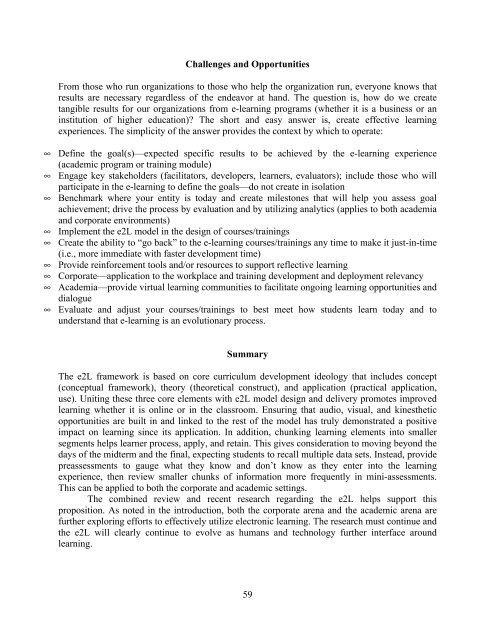Journal of Research in Innovative Teaching - National University
Journal of Research in Innovative Teaching - National University
Journal of Research in Innovative Teaching - National University
You also want an ePaper? Increase the reach of your titles
YUMPU automatically turns print PDFs into web optimized ePapers that Google loves.
Challenges and Opportunities<br />
From those who run organizations to those who help the organization run, everyone knows that<br />
results are necessary regardless <strong>of</strong> the endeavor at hand. The question is, how do we create<br />
tangible results for our organizations from e-learn<strong>in</strong>g programs (whether it is a bus<strong>in</strong>ess or an<br />
<strong>in</strong>stitution <strong>of</strong> higher education) The short and easy answer is, create effective learn<strong>in</strong>g<br />
experiences. The simplicity <strong>of</strong> the answer provides the context by which to operate:<br />
• Def<strong>in</strong>e the goal(s)—expected specific results to be achieved by the e-learn<strong>in</strong>g experience<br />
(academic program or tra<strong>in</strong><strong>in</strong>g module)<br />
• Engage key stakeholders (facilitators, developers, learners, evaluators); <strong>in</strong>clude those who will<br />
participate <strong>in</strong> the e-learn<strong>in</strong>g to def<strong>in</strong>e the goals—do not create <strong>in</strong> isolation<br />
• Benchmark where your entity is today and create milestones that will help you assess goal<br />
achievement; drive the process by evaluation and by utiliz<strong>in</strong>g analytics (applies to both academia<br />
and corporate environments)<br />
• Implement the e2L model <strong>in</strong> the design <strong>of</strong> courses/tra<strong>in</strong><strong>in</strong>gs<br />
• Create the ability to “go back” to the e-learn<strong>in</strong>g courses/tra<strong>in</strong><strong>in</strong>gs any time to make it just-<strong>in</strong>-time<br />
(i.e., more immediate with faster development time)<br />
• Provide re<strong>in</strong>forcement tools and/or resources to support reflective learn<strong>in</strong>g<br />
• Corporate—application to the workplace and tra<strong>in</strong><strong>in</strong>g development and deployment relevancy<br />
• Academia—provide virtual learn<strong>in</strong>g communities to facilitate ongo<strong>in</strong>g learn<strong>in</strong>g opportunities and<br />
dialogue<br />
• Evaluate and adjust your courses/tra<strong>in</strong><strong>in</strong>gs to best meet how students learn today and to<br />
understand that e-learn<strong>in</strong>g is an evolutionary process.<br />
Summary<br />
The e2L framework is based on core curriculum development ideology that <strong>in</strong>cludes concept<br />
(conceptual framework), theory (theoretical construct), and application (practical application,<br />
use). Unit<strong>in</strong>g these three core elements with e2L model design and delivery promotes improved<br />
learn<strong>in</strong>g whether it is onl<strong>in</strong>e or <strong>in</strong> the classroom. Ensur<strong>in</strong>g that audio, visual, and k<strong>in</strong>esthetic<br />
opportunities are built <strong>in</strong> and l<strong>in</strong>ked to the rest <strong>of</strong> the model has truly demonstrated a positive<br />
impact on learn<strong>in</strong>g s<strong>in</strong>ce its application. In addition, chunk<strong>in</strong>g learn<strong>in</strong>g elements <strong>in</strong>to smaller<br />
segments helps learner process, apply, and reta<strong>in</strong>. This gives consideration to mov<strong>in</strong>g beyond the<br />
days <strong>of</strong> the midterm and the f<strong>in</strong>al, expect<strong>in</strong>g students to recall multiple data sets. Instead, provide<br />
preassessments to gauge what they know and don’t know as they enter <strong>in</strong>to the learn<strong>in</strong>g<br />
experience, then review smaller chunks <strong>of</strong> <strong>in</strong>formation more frequently <strong>in</strong> m<strong>in</strong>i-assessments.<br />
This can be applied to both the corporate and academic sett<strong>in</strong>gs.<br />
The comb<strong>in</strong>ed review and recent research regard<strong>in</strong>g the e2L helps support this<br />
proposition. As noted <strong>in</strong> the <strong>in</strong>troduction, both the corporate arena and the academic arena are<br />
further explor<strong>in</strong>g efforts to effectively utilize electronic learn<strong>in</strong>g. The research must cont<strong>in</strong>ue and<br />
the e2L will clearly cont<strong>in</strong>ue to evolve as humans and technology further <strong>in</strong>terface around<br />
learn<strong>in</strong>g.<br />
59

















